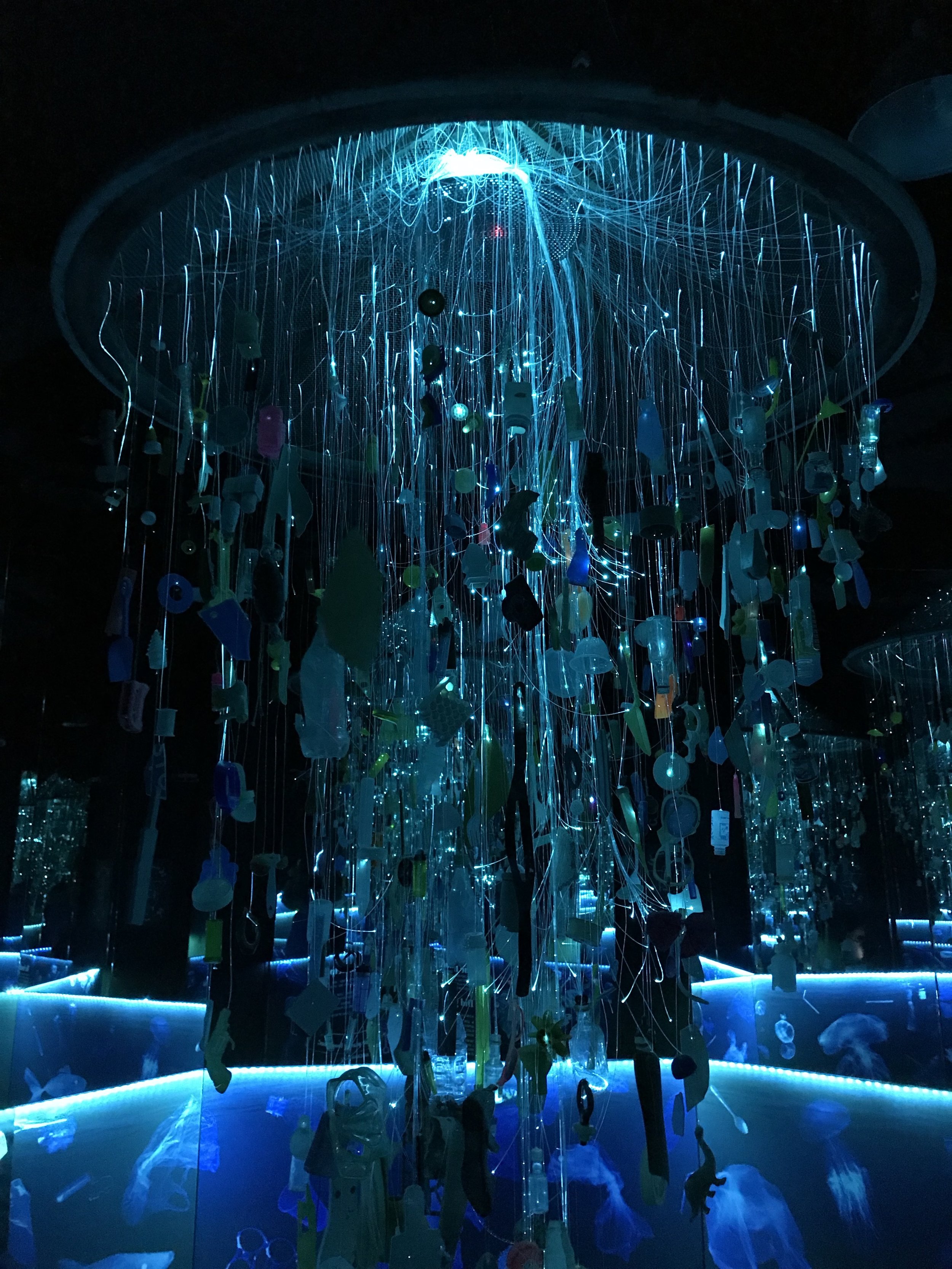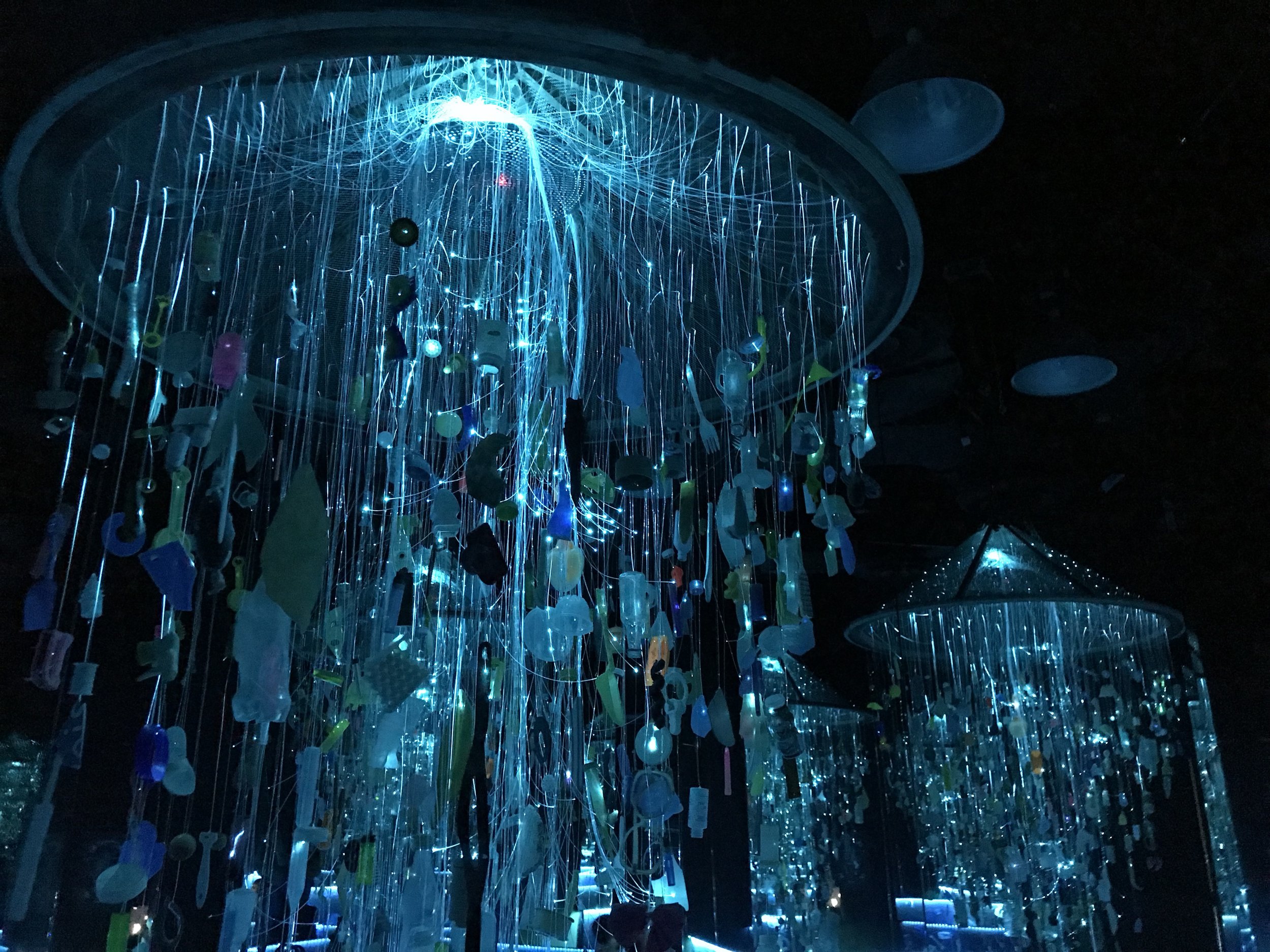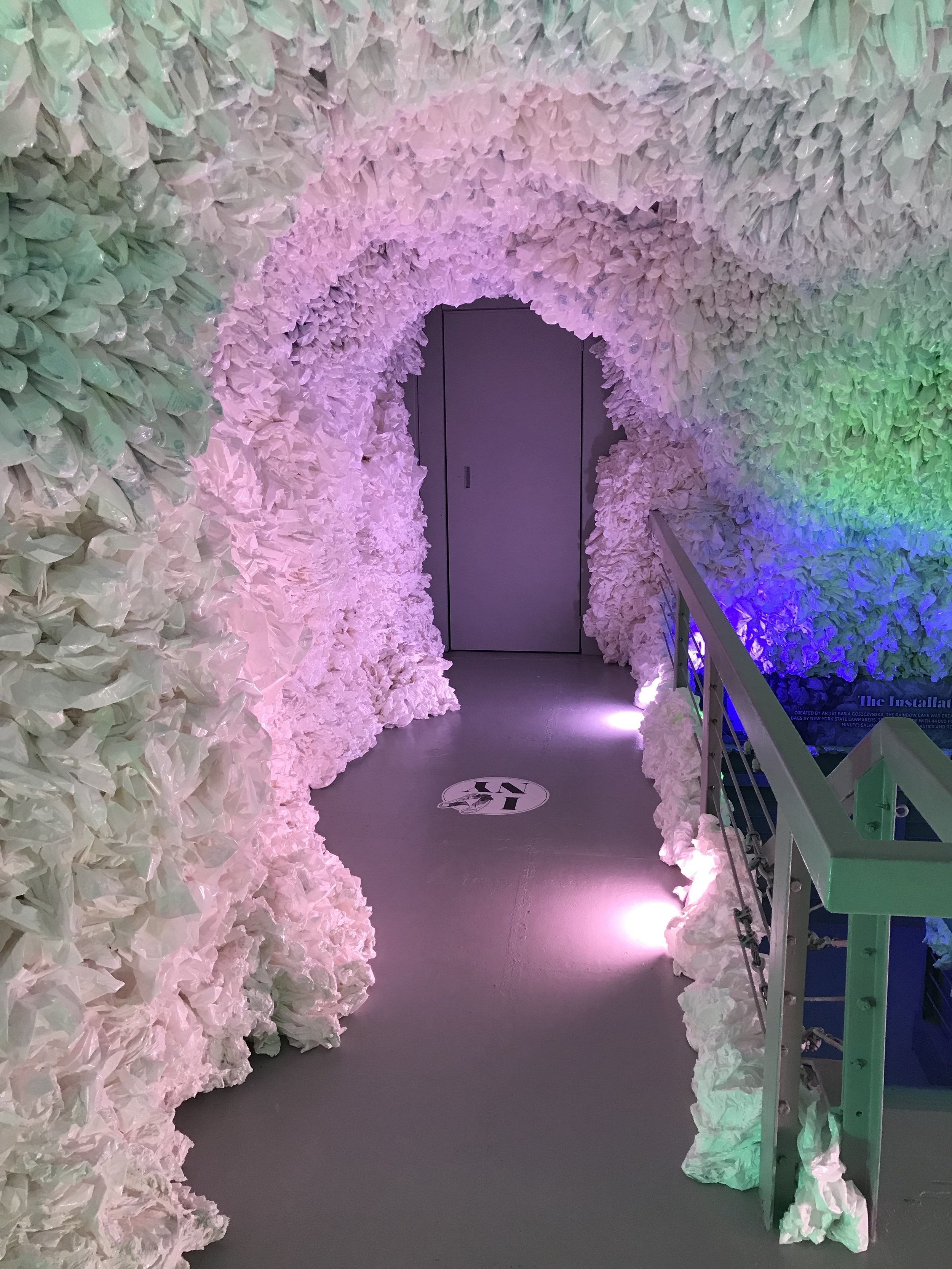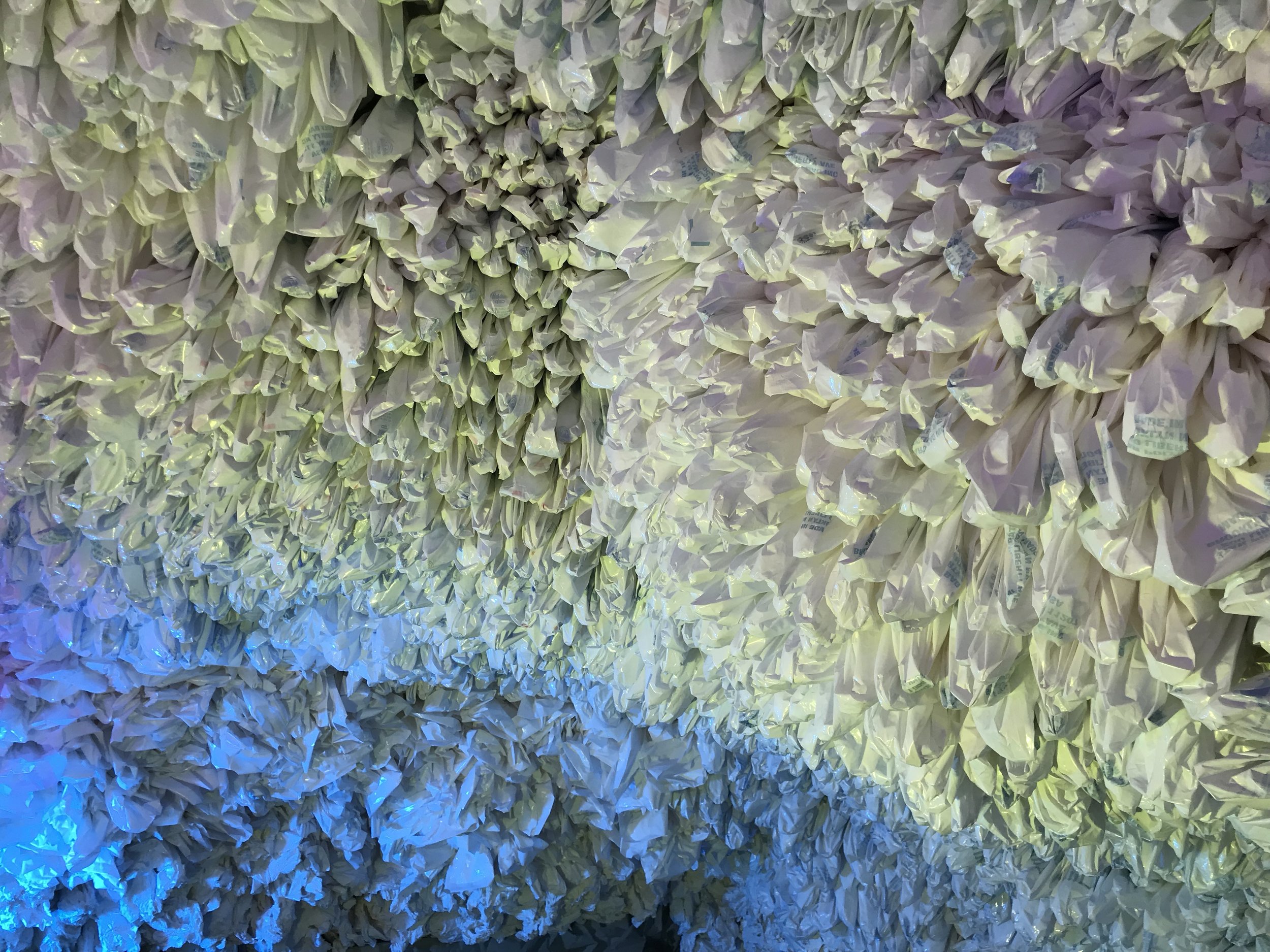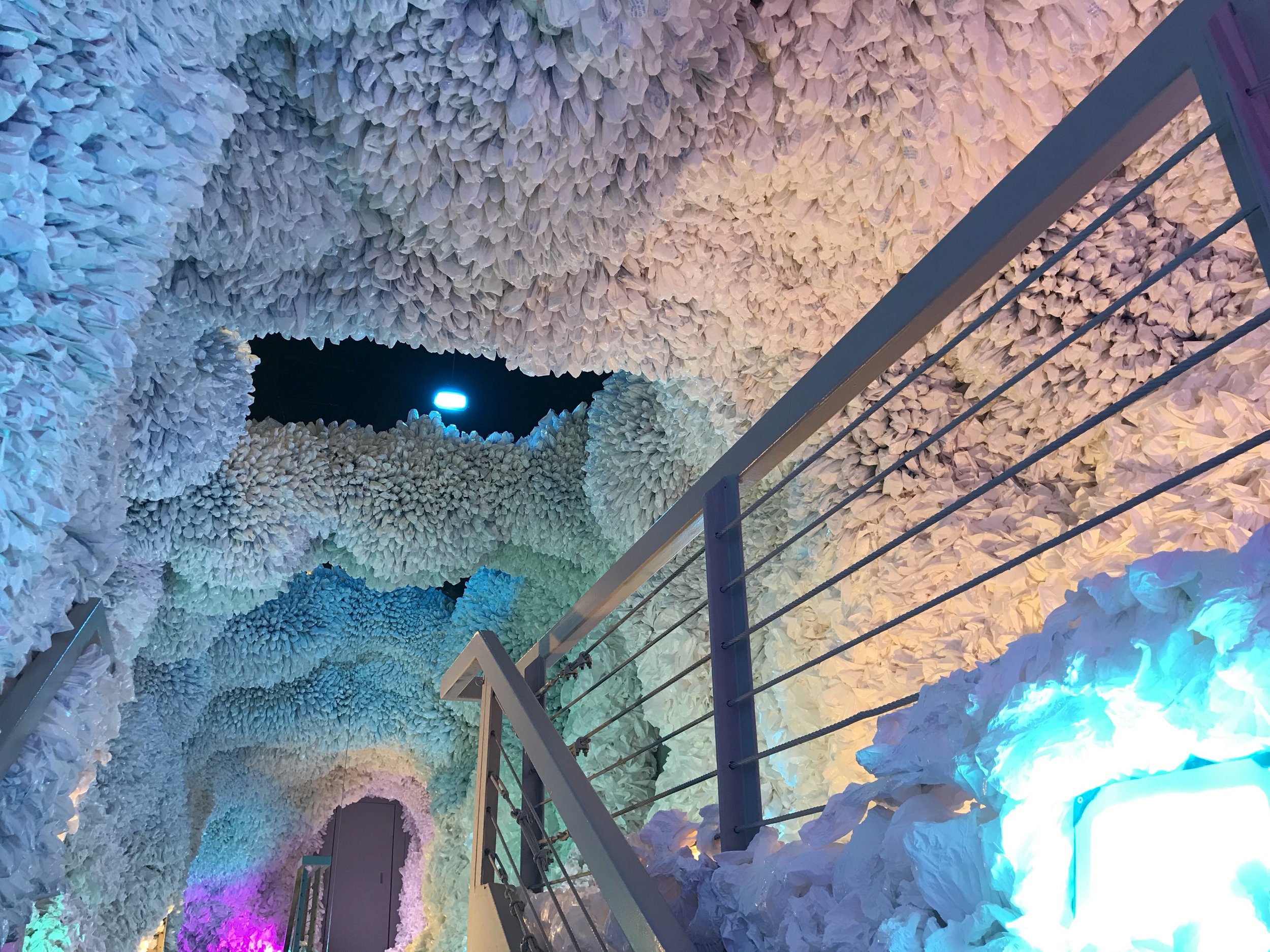#arcadiaearth
[In this blog entry, we meet M., my adventure buddy. M. has given me permission to occasionally include her in my blog posts about things that “other kids might like.” What you need to know is that like all heroines, M. has a spunky sense of adventure, is always ready to explore, and has lots of questions about the world. We try to answer those questions by having adventures. M. and I prefer to travel by ferry on our adventures. Sometimes, M. sports purple hair with a magnifying glass on the side. That’s all you need to know for now!]
This week, my adventure buddy, M. and I celebrated the end of summer by visiting a new art exhibit in Manhattan called Arcadia Earth. Although I had read about it online, we weren’t entirely sure what we were going to see.
One of the symbols in #arcadiaearth that activates the augmented reality (AR) content.
Photo credit: Liz Summit, 2019
The temporary museum (a “pop up”), Arcadia Earth is a series of rooms with original art installations. 1/2 of the rooms focus on water. The other 1/2 focus on land. Each art installation has two hidden layers. First: things are not exactly as they seem. In each room, you discover the relationship between the natural world and our human actions. Second, at the beginning of the exhibit, you are given an iPad. Focusing the iPad on symbols on the walls and floors unlocks an “Augmented Reality” or AR layer. If you’re familiar with Pokemon Go, then you already know what this is. Basically, the iPad shows you the scene you’re looking at with extra content.
Excited by what we’d seen online, prepared with our iPad, and with our keen sense of adventure, M. and I headed into Arcadia Earth. I’m going to focus on 6 rooms (there are many more!) that I particularly enjoyed.
It’s Beautiful Until…
I’ve written about the problem of plastics in the ocean many times before, so it will probably come as little surprise to you that I was fascinated by a piece called “Gyre Chandelier” by artist Cindy Pease Roe. When you first enter the room, beautiful blue light streams from the ceiling. Bioluminescent jellyfish shimmer, their dangling tentacles twinkling as they sway back and forth. Here, the use of mirrors makes it seem like you’re floating in a dark ocean with hints of a magic world all around you. But, as you draw closer, you discover that the jellyfish are made of plastic garbage.
I said, “I think this room is beautiful.”
M. said, “Sure, until you realize what the jellyfish are made of. Then it’s really ugly.”
Numbers Matter
If you’re like me, numbers can be hard to imagine. The Rainbow Cave, created by artist Basia Goszczynska was designed to illustrate this very problem.
When you go to the store and receive a plastic bag for your items, that might not seem like a big deal (although M. pointed out that in her house, there is a cupboard full of unwanted plastic bags taking up space. I have a similar cupboard in my house, despite the fact that we both take our own reusable bags most of the time.). Who cares about 1 little plastic bag? But, in New York state, 44,000 bags are used every minute. What does 44,000 look like?
Guess what? The Rainbow Cave is made out of 44,000 bags. And that’s a LOT of bags! Like the Gyre Chandelier, it’s hauntingly beautiful until you realize what you’re really looking at.
We are Breathing the Ocean
Creation of Oxygen by Justin Bolognino and Eric Chang
Photo Credit: Liz Summit, 2019
One of my favorite rooms was a series of scenes projected on walls. You lay down on a beanbag and purple bubbles begin to grow and float up to the ceiling. They are transformed into trees and then mountains. Artists Justin Bolognino and Eric Chang wanted to show how oxygen begins with the tiny, microscopic creatures in the ocean called phytoplankton. Phytoplankton are responsible for 70% of the earth’s oxygen. (While I was relaxing in the beanbag chairs, M. was busy with the AR, chasing orcas around the room as they swam overhead.)
Seeing the Unseen
Poramit Thantapalit’s installation on micro plastics (the tiny bits of plastic that end up in the ocean, so small, we can’t even see them), features jellyfish made out of plastic bags. In this exhibit, the AR really worked well. You can see M’s iPad here. While I’m looking at the plastic jellyfish over her head, she’s looking at the jellyfish through the AR filter. Her screen is filled with micro plastic litter. I thought this room did a great job of helping us to see something so tiny, it’s hard to imagine why it matters. M. would also like you to know that she noticed most of the bags were from Target, immediately recognizable by their ubiquitous red circles. “Target shouldn’t use plastic bags,” she said.
Poramit Thantapalit’s installation on micro plastics
Photo Credit: Liz Summit, 2019
Poramit Thantapalit’s installation on micro plastics
Photo Credit: Liz Summit, 2019
Everywhere You Turn, Everywhere You Will Turn
Etty Yaniv’s “Tsunami of Plastic”
Photo credit: Liz Summit, 2019
Brooklyn artist Etty Yaniv’s “Tsunami of Plastic” was mind-boggling. Created from plastic trash in Manhattan offices, this room asked us to think about our relationship with plastic and how we have created a major problem with plastics, a tsunami of garbage with nowhere to go.
Etty Yaniv’s “Tsunami of Plastic”
Photo credit: Liz Summit, 2019
For me, seeing my adventure buddy M. underneath a wave of plastic represents the challenge for the future. How do we all work together to make change happen?
What’s Your Vow?
My Vow at #arcadiaearth : FIX IT
Photo Credit: M, 2019
The haunting and beautiful world of Arcadia Earth asks us what’s at stake for our world? The artists in the exhibit have created powerful work that is beautiful and disturbing at the same time.
Their work helps us to ask: what changes can we make to help protect the oceans, the land, the animals, nature that is seen and unseen, and ourselves?
At the end of the exhibit, we were invited to make a vow about something we’d like to change. I chose “Fix it.” I’m going to focus on trying to fix things that break instead of replacing them. M. is going to try hard not to waste food. Both of these are small steps. But, remember those plastic bags? Everyone who visits Arcadia Earth can choose to make a vow. Who knows how many small and large changes that can add up to! Remember, 44,000 bags can do a lot of harm to our water and land. Imagine how much good 44,000 vows could do!
My Vow: FIX IT (instead of replacing it!)
Photo Credit: M, 2019
We Highly Recommend #arcadiaearth
If you are in Manhattan, or if you can visit in the next few months, M. and I highly recommend Arcadia Earth. It’s beautiful, provocative, and inspiring. We loved exploring the imagination and possibility of each room. We loved learning more about what we can do to help the planet. And, we loved the fully interactive physical and digital aspects of Arcadia Earth. This is a pretty high “recommend” from both me and M. for grups and young adventurers alike. There is something for everyone. And now, more than ever, we need all the chances we can get to figure out how make big and small changes for our planet.
More about #arcadiaearth
Grup Zone: Talking To Your Kids About Climate Change
A side note for fellow grups: M. found the exhibit on fishing nets somewhat disturbing, so we rushed through that. Other young adventurers might have some questions about the installation on eating less meat. My advice: be prepared to move quickly through 1 or 2 rooms if your young adventurer isn’t caught up in the magic and mystery of the room.
Talking to kids about climate change can be hard. Most advice focuses on three key ideas:
1. Make sure what you’re sharing is age appropriate;
2. Start first with kids’ wonder of the natural world: get them invested in what they love and use that as a starting point for discussion;
3. Give them concrete ways they can help.
Here are a few resources to help you get started:
“How To Talk To Your Kids About Climate Change Without Scaring Them”
https://mashable.com/article/climate-change-talking-to-kids/
“Talking To Your Kids About Climate Change”
https://www.nationalgeographic.com/family/talking-to-your-kids-about-climate-change/
“How To Talk To Your Kids About Global Warming”



